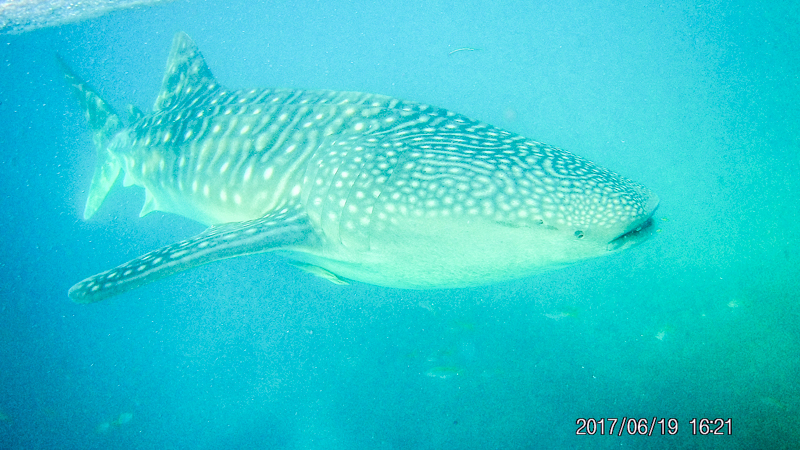Swimming with Whalesharks in Oslob

My family is from Cebu, Philippines, so I’m spending a good amount of time on the island seeing the sites and meeting relatives. Over the weekend, a few distant cousins and I hopped in a car at 3am and drove three hours from Talisay to Oslob to see the whalesharks, the world’s largest living fish at 35-40ft in length.
We got to Oslob a little after 6am, so it wasn’t crowded at all. You have the option of viewing the whalesharks from a boat, snorkeling, or scuba diving.
Snorkeling cost PHP1000 (about $20 USD), all inclusive of gear rental. After sitting through a short orientation where they went over the rules (no sunscreen, stay near the boat, stay 4m away from the whalesharks at all times, if the whaleshark approaches you, don’t touch it), we got on the boats, and off we went!
 (Sorry about the time stamps, I’m a newb, and this was my first time using this particular camera)
(Sorry about the time stamps, I’m a newb, and this was my first time using this particular camera)
Each boat held about 8 people, and we were allowed in the water for 30 minutes. The guides used krill to attract the whalesharks, so we had 2 swimming around us the entire time!


Is swimming with the whalesharks in Oslob ethical?
When I travel, I try to be as responsible as possible, so swimming with the whalesharks gives me mixed emotions. On one hand, the Filipino government has been doing more to regulate the tourism industry (they’re shutting down Boracay—one of the main tourist islands of the country—because of environmental issues). In the past year, they’ve restricted the hours of operation to view the whalesharks so that the last boat leaves at noon, and the guides are pretty strict in enforcing the sunscreen and 4m rule. The money made from tourism also helps the local economy, which is a big deal in developing countries where the population is growing and jobs are not always readily available.
On the other hand, the guides use krill to attract the whalesharks, which changes their natural feeding behavior. Because the whalesharks expect to be fed at the same time everyday, they stay in one place instead of migrating to another coast, their diets are not as diverse, and this can have longterm effects on their migratory and reproduction patterns. The whalesharks are also beginning to associate boats with food, which can lead to propellor-related injuries. Because whalesharks are classified as an endangered species, harming even one whaleshark can have negative repercussions.
If you’re looking for a more ethical way to see the whalesharks, there’s the Donsol Community-Based Whale Shark Ecotourism Program in Donsol, Sorsogon. They’re affiliated with WWF Philippines, are committed to the sustainability of the whaleshark population, and have strict rules against feeding the whalesharks, diving, or doing anything that would impact their natural habitats.
Like with most ethical dilemmas, there really isn’t a right answer to all of this. Personally, if I could do it all over, I would plan better and go to Donsol instead of Oslob. But I do feel comfortable in saying that while the system isn’t perfect, Oslob does have guidelines in place to protect the creatures, and as more research on whalesharks occurs and whaleshark tourism matures, regulations will continue to evolve.
